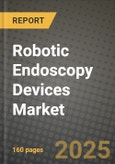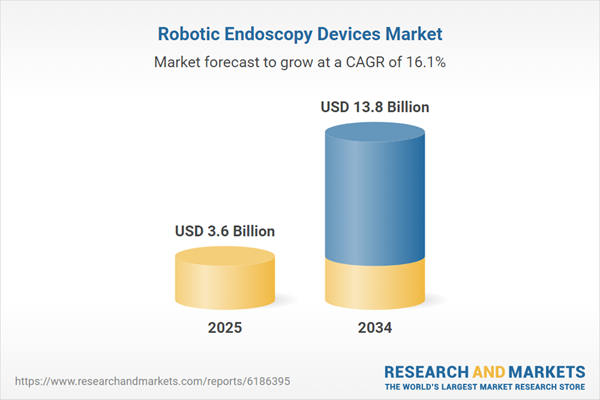The Robotic Endoscopy Devices market is rapidly emerging as a game-changing innovation in minimally invasive diagnostics and surgeries, offering enhanced precision, flexibility, and control during complex medical procedures. These devices combine robotics and advanced imaging technologies to navigate the human body with minimal trauma, particularly in gastrointestinal, urological, and pulmonary applications. Unlike traditional endoscopy, robotic-assisted systems enable surgeons to perform highly accurate interventions with improved ergonomics, reduced fatigue, and fewer complications. With the rising global burden of chronic diseases, an aging population, and the need for early and accurate diagnostics, the demand for robotic endoscopy is accelerating. Healthcare providers are increasingly adopting these devices for their ability to deliver superior visualization, real-time feedback, and precise maneuvering in delicate anatomical regions. As technological innovation continues and clinical outcomes improve, robotic endoscopy is set to become an integral part of next-generation surgical and diagnostic platforms.
The Robotic Endoscopy Devices market experienced notable advancements, driven by product innovation, regulatory approvals, and strategic collaborations. Companies like Medtronic, Intuitive Surgical, and EndoMaster launched enhanced platforms featuring AI-assisted navigation, real-time 3D mapping, and miniaturized robotic arms. These developments significantly improved the accuracy of diagnostic biopsies and therapeutic procedures, particularly in early-stage cancer detection. Several healthcare institutions expanded their use of robotic endoscopy in outpatient settings, reflecting its growing clinical acceptance and procedural efficiency. Additionally, software updates and cloud-enabled data analytics began playing a more significant role, offering physicians actionable insights during and after procedures. Governments in North America, Europe, and Asia-Pacific increased funding for advanced surgical robotics, while training centers integrated robotic endoscopy modules into medical curricula. These developments collectively laid a strong foundation for market maturity, moving robotic endoscopy from niche innovation to routine practice in specialized medical centers.
The Robotic Endoscopy Devices market is expected to gain further momentum through the integration of AI, machine learning, and autonomous functionality. Future systems will incorporate intelligent image recognition to assist in real-time diagnosis, while robotics will become more compact, wireless, and adaptable to various clinical environments. Expansion into ambulatory surgical centers and mid-tier hospitals will drive broader accessibility, especially in emerging markets. Additionally, personalized medicine will influence endoscopy workflows, with robotic systems adapting to patient-specific anatomical variations and disease profiles. The rise of remote and tele-robotic procedures will also enable experienced specialists to conduct complex endoscopies in underserved regions, addressing healthcare inequality. With more players entering the market and continuous technological refinement, competitive pricing and interoperability with existing hospital infrastructure will become focal points. The combination of clinical need, innovation, and global health trends positions robotic endoscopy to redefine how minimally invasive diagnostics and therapies are performed worldwide.
Key Insights: Robotic Endoscopy Devices Market
- AI-driven image analysis is being integrated into robotic endoscopy platforms to assist physicians in detecting lesions and abnormalities more accurately during real-time procedures.
- Miniaturization of robotic endoscopic components is enabling deeper access into hard-to-reach anatomical areas, especially within the gastrointestinal and bronchial systems.
- Wireless and capsule-based robotic endoscopy devices are gaining attention for non-invasive diagnostic procedures, offering improved patient comfort and accessibility.
- Cloud-connected platforms are enhancing post-procedural analytics, enabling better clinical decision-making and integration with hospital data management systems.
- Medical education and simulation centers are increasingly incorporating robotic endoscopy into training programs to prepare the next generation of skilled operators.
- Rising incidence of chronic gastrointestinal and pulmonary diseases is fueling demand for early diagnosis through advanced, minimally invasive techniques like robotic endoscopy.
- Technological advancements in robotics, imaging, and AI are improving procedural precision, reducing complications, and enhancing patient recovery outcomes.
- Increased healthcare spending and adoption of advanced surgical infrastructure in both developed and emerging markets are expanding the reach of robotic endoscopy.
- Growing preference for outpatient and day-care procedures is driving the adoption of compact, efficient robotic endoscopy systems that reduce hospital stays and costs.
- The high cost of robotic endoscopy systems, along with the need for specialized training and infrastructure, limits accessibility for smaller hospitals and healthcare facilities, especially in resource-constrained regions.
Robotic Endoscopy Devices Market Segmentation
By Product
- Diagnostic
- Therapeutic
By Application
- Colonoscopy
- Bronchoscopy
- Laparoscopy
- Gastrointestinal Endoscopy
- Other Application
By End User
- Hospitals
- Ambulatory Surgical Centers
- Other End Users
Key Companies Analysed
- Johnson & Johnson Services Inc.
- Medtronic PLC
- FUJIFILM Holdings Corporation
- Stryker Corporation
- Boston Scientific Corporation
- B. Braun Melsungen AG
- Carl Zeiss AG
- Olympus Corporation
- HOYA Corporation
- Intuitive Surgical Inc.
- Smith + Nephew GmbH
- Arthrex Inc.
- ENDO Robotics Co Ltd.
- Karl Storz SE & Co. KG
- Auris Health Inc.
- Cantel Medical Corp.
- ConMed Corporation
- Ambu A/S
- Richard Wolf GmbH
- Brainlab AG
- Renishaw plc.
- Fortimedix Surgical B.V.
- CapsoVision Inc.
- Asensus Surgical Inc.
- Medrobotics Corporation
- EndoMaster Pte Ltd.
- Ovesco Endoscopy AG
- Medineering GmbH
- Virtuoso Surgical Inc.
- Gray Optics Co
Robotic Endoscopy Devices Market Analytics
The report employs rigorous tools, including Porter’s Five Forces, value chain mapping, and scenario-based modeling, to assess supply-demand dynamics. Cross-sector influences from parent, derived, and substitute markets are evaluated to identify risks and opportunities. Trade and pricing analytics provide an up-to-date view of international flows, including leading exporters, importers, and regional price trends.Macroeconomic indicators, policy frameworks such as carbon pricing and energy security strategies, and evolving consumer behavior are considered in forecasting scenarios. Recent deal flows, partnerships, and technology innovations are incorporated to assess their impact on future market performance.
Robotic Endoscopy Devices Market Competitive Intelligence
The competitive landscape is mapped through proprietary frameworks, profiling leading companies with details on business models, product portfolios, financial performance, and strategic initiatives. Key developments such as mergers & acquisitions, technology collaborations, investment inflows, and regional expansions are analyzed for their competitive impact. The report also identifies emerging players and innovative startups contributing to market disruption.Regional insights highlight the most promising investment destinations, regulatory landscapes, and evolving partnerships across energy and industrial corridors.
Countries Covered
- North America - Robotic Endoscopy Devices market data and outlook to 2034
- United States
- Canada
- Mexico
- Europe - Robotic Endoscopy Devices market data and outlook to 2034
- Germany
- United Kingdom
- France
- Italy
- Spain
- BeNeLux
- Russia
- Sweden
- Asia-Pacific - Robotic Endoscopy Devices market data and outlook to 2034
- China
- Japan
- India
- South Korea
- Australia
- Indonesia
- Malaysia
- Vietnam
- Middle East and Africa - Robotic Endoscopy Devices market data and outlook to 2034
- Saudi Arabia
- South Africa
- Iran
- UAE
- Egypt
- South and Central America - Robotic Endoscopy Devices market data and outlook to 2034
- Brazil
- Argentina
- Chile
- Peru
Research Methodology
This study combines primary inputs from industry experts across the Robotic Endoscopy Devices value chain with secondary data from associations, government publications, trade databases, and company disclosures. Proprietary modeling techniques, including data triangulation, statistical correlation, and scenario planning, are applied to deliver reliable market sizing and forecasting.Key Questions Addressed
- What is the current and forecast market size of the Robotic Endoscopy Devices industry at global, regional, and country levels?
- Which types, applications, and technologies present the highest growth potential?
- How are supply chains adapting to geopolitical and economic shocks?
- What role do policy frameworks, trade flows, and sustainability targets play in shaping demand?
- Who are the leading players, and how are their strategies evolving in the face of global uncertainty?
- Which regional “hotspots” and customer segments will outpace the market, and what go-to-market and partnership models best support entry and expansion?
- Where are the most investable opportunities - across technology roadmaps, sustainability-linked innovation, and M&A - and what is the best segment to invest over the next 3-5 years?
Your Key Takeaways from the Robotic Endoscopy Devices Market Report
- Global Robotic Endoscopy Devices market size and growth projections (CAGR), 2024-2034
- Impact of Russia-Ukraine, Israel-Palestine, and Hamas conflicts on Robotic Endoscopy Devices trade, costs, and supply chains
- Robotic Endoscopy Devices market size, share, and outlook across 5 regions and 27 countries, 2023-2034
- Robotic Endoscopy Devices market size, CAGR, and market share of key products, applications, and end-user verticals, 2023-2034
- Short- and long-term Robotic Endoscopy Devices market trends, drivers, restraints, and opportunities
- Porter’s Five Forces analysis, technological developments, and Robotic Endoscopy Devices supply chain analysis
- Robotic Endoscopy Devices trade analysis, Robotic Endoscopy Devices market price analysis, and Robotic Endoscopy Devices supply/demand dynamics
- Profiles of 5 leading companies - overview, key strategies, financials, and products
- Latest Robotic Endoscopy Devices market news and developments
Additional Support
With the purchase of this report, you will receive:- An updated PDF report and an MS Excel data workbook containing all market tables and figures for easy analysis.
- 7-day post-sale analyst support for clarifications and in-scope supplementary data, ensuring the deliverable aligns precisely with your requirements.
- Complimentary report update to incorporate the latest available data and the impact of recent market developments.
This product will be delivered within 1-3 business days.
Table of Contents
Companies Mentioned
- Johnson & Johnson Services Inc.
- Medtronic PLC
- FUJIFILM Holdings Corporation
- Stryker Corporation
- Boston Scientific Corporation
- B. Braun Melsungen AG
- Carl Zeiss AG
- Olympus Corporation
- HOYA Corporation
- Intuitive Surgical Inc.
- Smith + Nephew GmbH
- Arthrex Inc.
- ENDO Robotics Co Ltd.
- Karl Storz SE & Co. KG
- Auris Health Inc.
- Cantel Medical Corp.
- ConMed Corporation
- Ambu A/S
- Richard Wolf GmbH
- Brainlab AG
- Renishaw PLC
- Fortimedix Surgical B.V.
- CapsoVision Inc.
- Asensus Surgical Inc.
- Medrobotics Corporation
- EndoMaster Pte Ltd.
- Ovesco Endoscopy AG
- Medineering GmbH
- Virtuoso Surgical Inc.
- Gray Optics Co
Table Information
| Report Attribute | Details |
|---|---|
| No. of Pages | 160 |
| Published | October 2025 |
| Forecast Period | 2025 - 2034 |
| Estimated Market Value ( USD | $ 3.6 Billion |
| Forecasted Market Value ( USD | $ 13.8 Billion |
| Compound Annual Growth Rate | 16.1% |
| Regions Covered | Global |
| No. of Companies Mentioned | 30 |









